Palm area with frictional ridges that leave an impression on a surface is called a palm print. And palm prints study along with fingerprints is collectively called Dermatoglyphics.
Are Palm Prints a Reliable Source of Evidence?

Palm prints are as reliable as fingerprints. They are unique and permanent and nearly all humans have them. The uniqueness and permanency of palm prints are governed by friction ridges development in the intrauterine phase.
Genetics and intrauterine environmental conditions are responsible for the uniqueness of the ridge details of the Palm area (or any ridge pattern including the footprints).
So, with that said, yes, Palmprint is reliable evidence, and many cases are successfully solved using palmprints.
Read More: 11 Reasons and Importance of Why Fingerprints Used for Identification in Forensic Science
Importance of Palm Prints and History

Following is the list of advantages of palm prints:
- Reliable: They are a reliable form of evidence of a person.
- Unbiased: Palmprints can’t be unbiased and couldn’t lead to different results (however, investigators could).
- They don’t lie: When a palm print is found it shows a personal presence to a scene or place and the person can’t deny it.
- Used as evidence for both criminal matters by linking, suspect, witness, or culprit to a particular case.
- Proving Theory: They assist in proving or disproving a set of circumstances or facts.
- Validate Information: It can also be used to corroborate information or statements.
- Biological Evidence: With a good amount of sweat or blood, palm prints can be a source of DNA.
- Occupational details can be obtained by studying palmprints.
- Speedy comparison and individualization when compared to DNA or other tests.
- Compare without a sophisticated tool: Two palmprint samples can be compared side-by-side without the use of any high-end devices.
Types of Palm Prints in Forensic

For studying palm prints as forensic evidence, they can be divided into four major types. These are (1) Visible, (2) Latent, (3) Patent and (4) Plastic palmprints.
1. Visible Palm Prints
These are easily seen by the naked eye and don’t need any developing agent or powder.
For example, when a person touches his/her inked palm on a wall. The wall registered the pattern from the palm area resulting in visible palm prints.
Read More: How To Record And Collect Palm Prints? Best Strategies And Guide
2. Latent Palmprints
These are prints that are not easily visible to the naked eye and need developing powder or a special lightning medium to observe them. There are the most common.
For example, when a palm area touches a surface without any external coloring agent, they usually result in latent prints without knowing.
3. Patent Palmprints
These prints are made by the acting force of a palm over a soft surface. For example, Palm prints are made on soap, sand, or mud.
4. Plastic Palmprints
These are prints due to a non-inked palm but an inked surface that is going to touch.
For example, if you touched a wet paint floor, the ink will transfer to your palm and fingers, leaving behind void marks. These are somewhat like patent palmprints.
Read More: Types of Fingerprints: History and Images Included
Classification of Palm Print
Classification of palm prints involves dividing the Palm area into three major regions and then determining or comparing the frictional ridges. The major sections of the Palmprint area are : (a) Interdigital (b) Hypothenar and (c) Thenar Region
| Region | Palm Area |
|---|---|
| Interdigital Region | Area from index finger to ring finger |
| Thenar | Area from half of the wrist to the index finger |
| Hypothenar | Area left by thenar and interdigital |
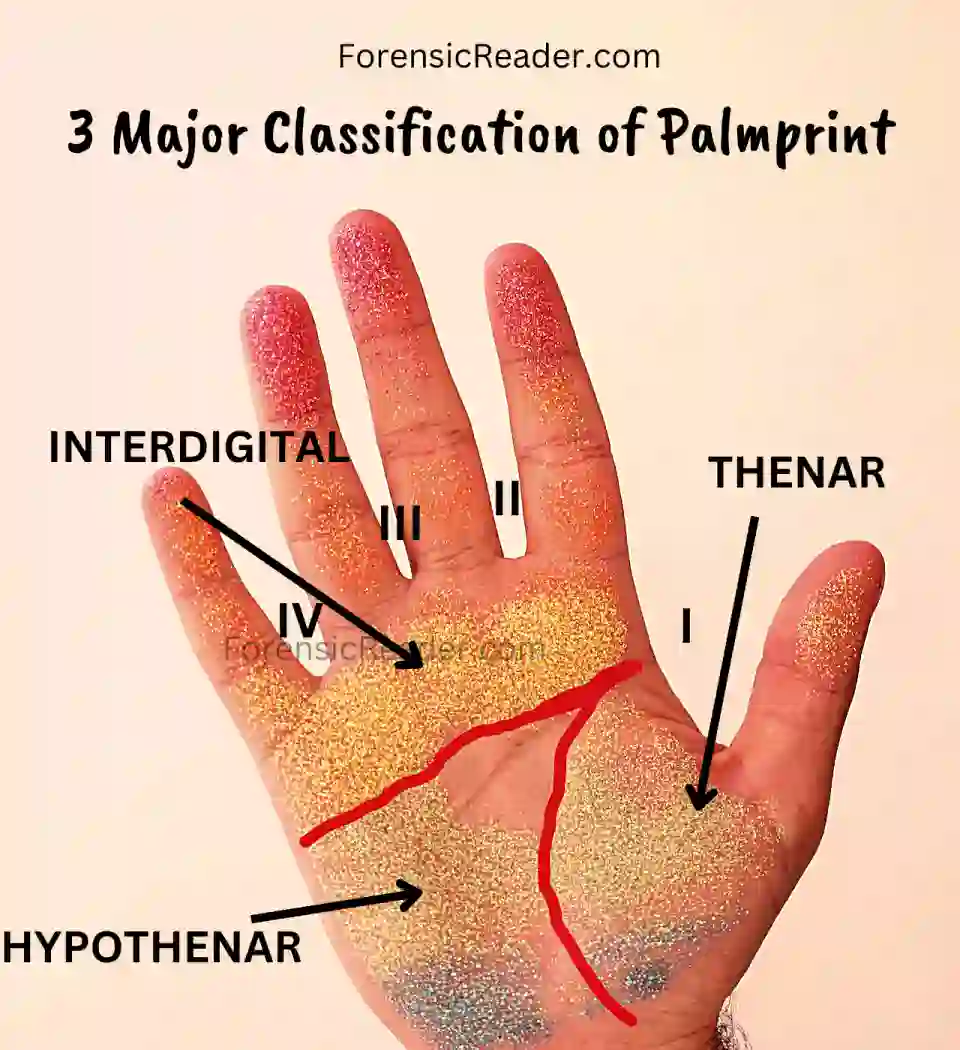
1. Interdigital Area
- The area between the index and ring fingers at the distal end of the palm.
- It is divided into 4 major parts.
- Part I: Interdigital space between thumb and index finger.
- Part II: Interdigital space between index and middle finger.
- Part III: Space between middle and ring finger.
- Part IV: Space between the ring and little finger.
2. Thenar Area
- The area from half of the wrist to the index finger.
- They have fewer overall patterns than other regions of the palm.
3. Hypothenar Area
- The area is bounded by the distal and ulnar margins of the palm and by principal line 1 (radial longitudinal crease) and principal line 2 (distance transverse crease).
Read More: Liverpool Palmprint Classification System: How to Calculate Values?
Main Patterns and Flexions of Palmprint Area

There are three main patterns that can are usually seen in the Palm area. These are
- Principal Lines
- Creases
- Wrinkles
1. Principal Lines
These are the main lines that run from one end of the palm to another. Commonly, there are three principal lines in the human palm:
- Line 1: starts in between the thumb and index finger and ends at the base of the palm. It is sometimes called radial longitudinal creases.
- Line 2: Starts from line 1 and runs towards the hypothenar part of the palm. It may or may not touches the other side of the palm. It is sometimes called proximal transverse creases.
- Line 3. Starts from the hypothenar part and moves towards the index finger and may or may not ends on the palm side of the index finger. It is sometimes called distal transverse creases.
- Datum points: end points of principal lines.
2. Short Creases
- These are the simple lines (or curves) that are usually seen in the area near the thumb or base of the palm.
- They are also called minor creases.
- One end of the creases starts outside the base and thumb area and enters the ridge area.
3. Wrinkles
- These are the inner and irregular lines as compared to the principal lines.
- They are usually driven by the inward movement of the thumb.
Types of Palm Prints Patterns and Ridge Characteristics
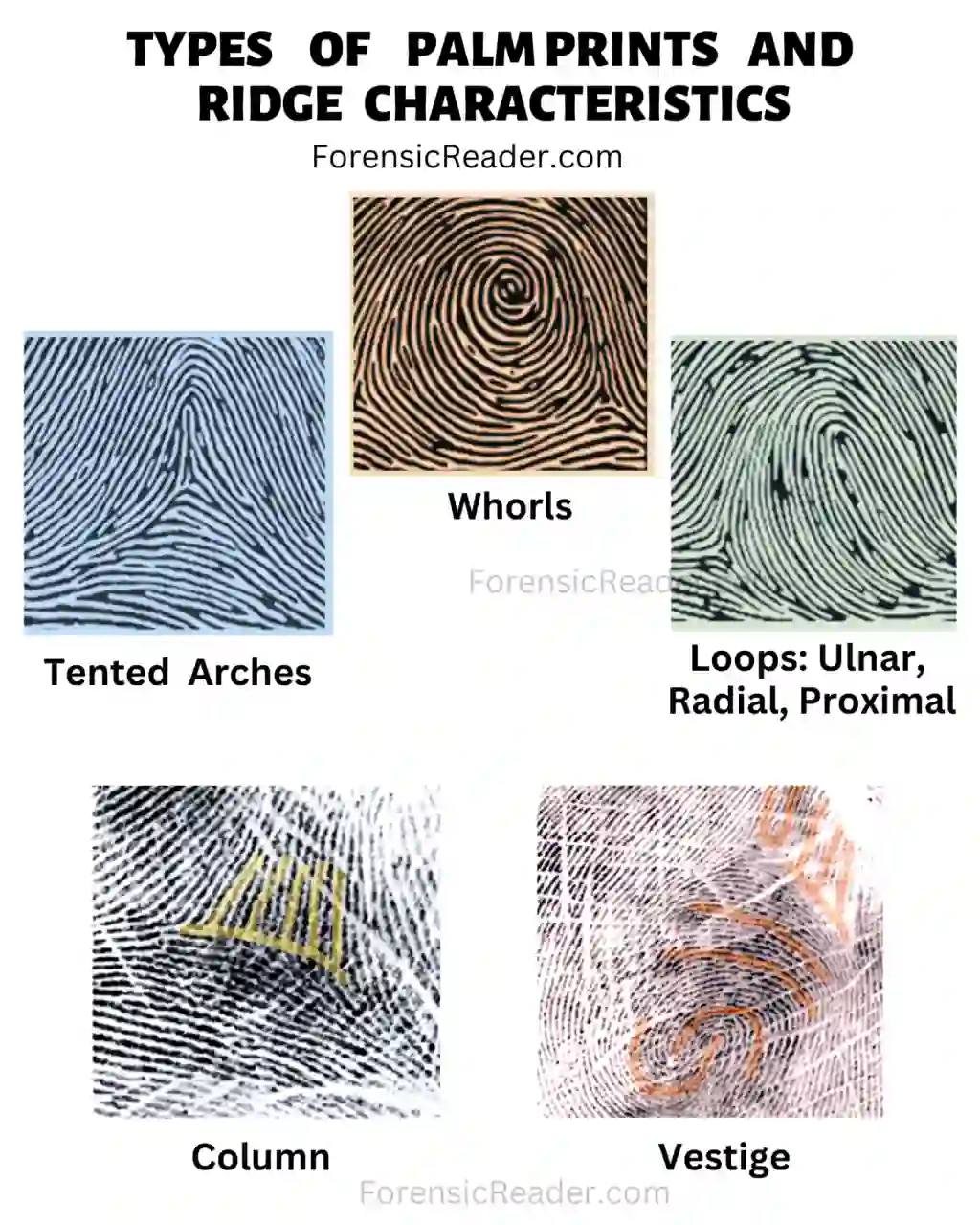
Palm print characteristics can be defined by the pattern types that appeared in their Interdigital, Hypothernar, and Thenar region. The Palm ridges can be characterized into 5 major groups. These are:
- Arches
- Loops: Ulnar, radial, proximal
- Whorls
- Column
- Vestige
1. Arches
Unlike fingerprints, where plain and tented arches are quite common, but with palmprints, usually tented arches are seen.
They usually appear in the interdigital region at the base of fingers (index to ring) where the ridge flows over a delta that formed loop-like patterns.
2. Loops
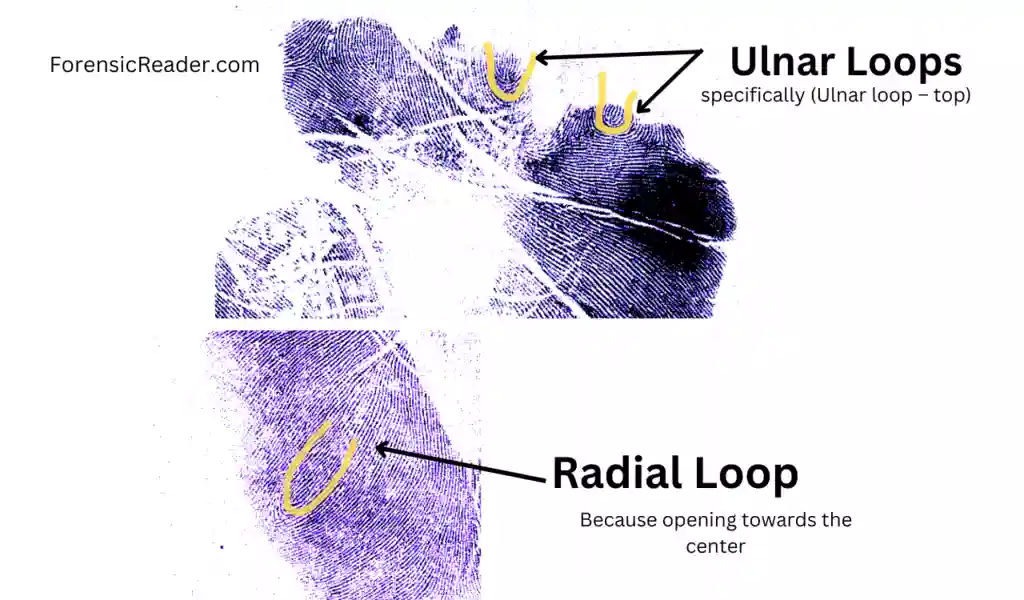
Three common loop patterns are Ulnar, radial, and proximal which are named as per their direction in the Palm area.
A. Ulnar Loops: These loops point toward the outer edge of the palm. They are further sub-characterized by the origin of the ridge flow.
- Ulnar loop – top: ridges flow into the ulnar loop from the top of the palm.
- Ulnar loop – base: ridge flows into the ulnar loop from the bottom of the palm.
B. Radial Loops: Loops pointing toward the center of the palm.
C. Proximal Loops: Loops points toward the base of the palm.
3. Whorls
Like fingerprints, in palmprints whorls are in the form of a complete circuit, which may be spiral, oval, circular, or any variant of a circle. Double-loop whorls are also possible.
4. Columns
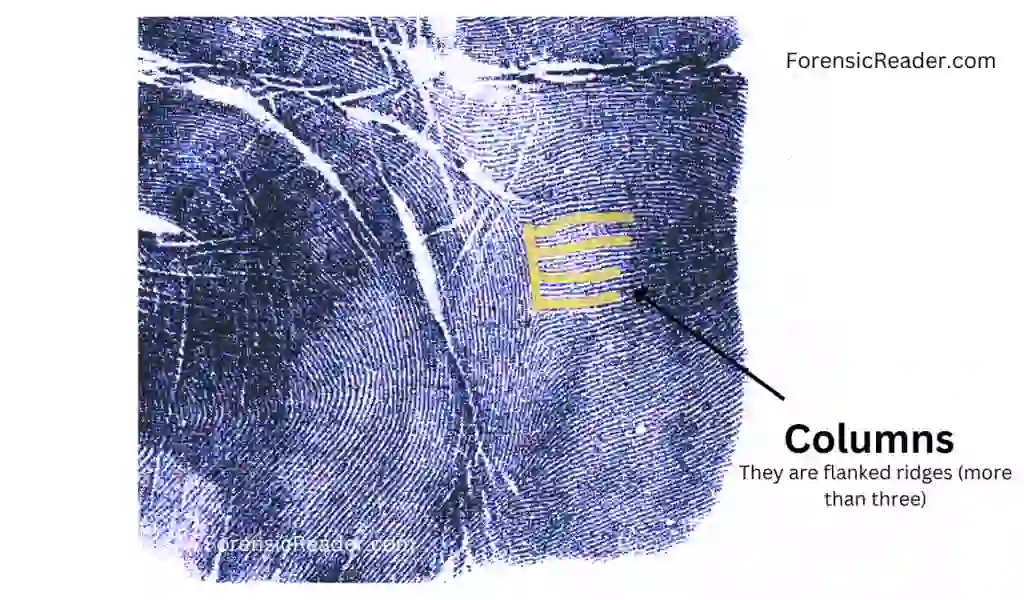
These patterns are in the form of a series of three or more ending frictional ridges of palm that are flanked on one or both sides by a delta.
5. Vestige
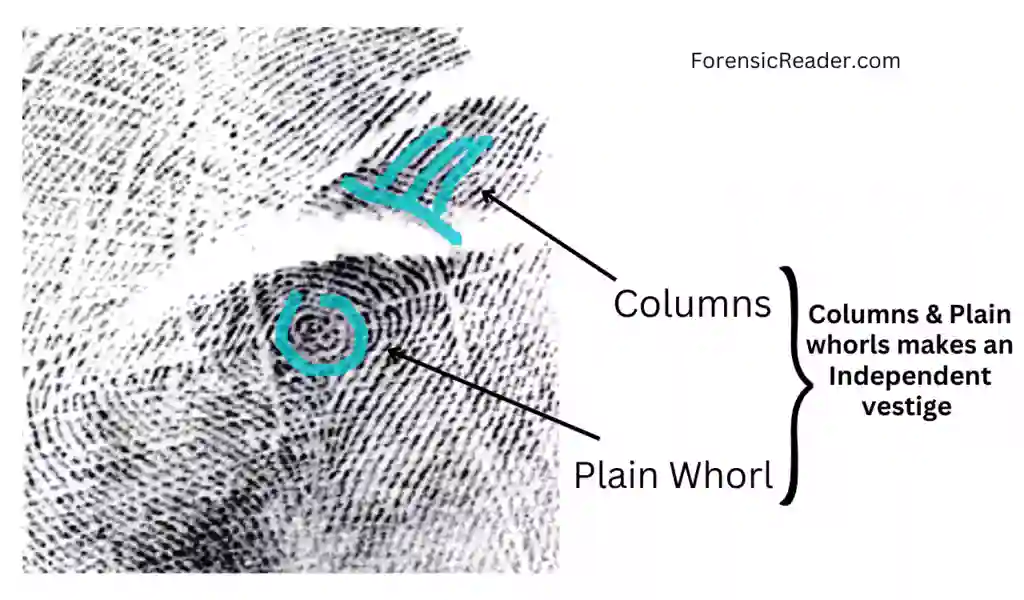
When a ridge flow opposite to the main flow of the ridge is called a vestige pattern. It could be small, independent, large, and in form of loops, columns, or whorls. They are unique to the thenar area of the palmprint.
Advantages of Palm Prints
- Larger area to compare with more features.
- Friction ridges of the palm stay throughout life, like fingerprints.
- They never change with time.
- Palm ridges are less likely to get damaged from injuries, scars, and occupational marks as compared to fingerprints.
- Lower chances of getting smudge palmprints.
Disadvantages
- Not as developed as a fingerprint.
- Their advantages usually fade over a fingerprint.
- Harder to get a palm print of the preparator from a crime scene than finger marks.
- If full hand fingermarks are analyzed, fingerprints are always looked at first for a match followed by palm area. It is more like corroborating evidence to fingerprint.
- Palm print recognition technology and databases are quite a few.
- Very few countries own a palm print database.
- Still need a lot of work in development.
References:
- Encyclopedia of Forensic Sciences by Elsevier [ScienceDirect]
- Palm print Classification based on inter-Distal Region Texture features [Academia]
- The Fingerprint Source by FBI
- Frictional Ridge Skin: Comparison and Identification of Fingerprint

FR Author Group at ForensicReader is a team of Forensic experts and scholars having B.Sc, M.Sc, or Doctorate( Ph.D.) degrees in Forensic Science. We published on topics on fingerprints, questioned documents, forensic medicine, toxicology, physical evidence, and related case studies. Know More.
